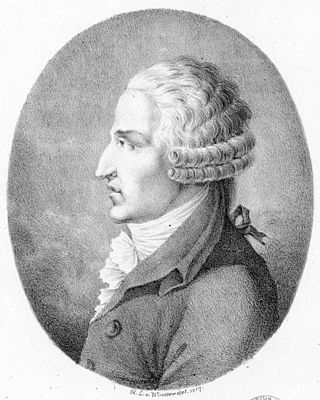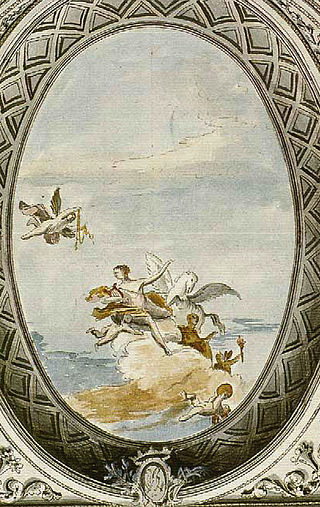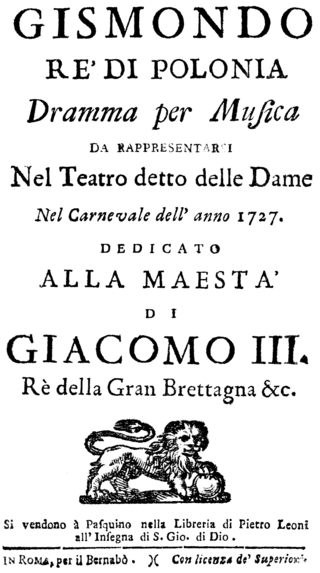
Pasquale Anfossi was an Italian opera composer. Born in Taggia, Republic of Genoa, he studied with Niccolò Piccinni and Antonio Sacchini, and worked mainly in London, Venice and Rome.

Fra i due litiganti il terzo gode is a dramma giocoso in two acts by Giuseppe Sarti. The libretto was after Carlo Goldoni's Le nozze.

Le gelosie villane is a dramma giocoso in three acts by Giuseppe Sarti. The libretto was by Tommaso Grandi. It was also known as Il feudatorio, Il feudatorio burlato and I contadini bizzari. It was also set by Pasquale Anfossi.

The Teatro Valle is a theatre and former opera house in Rome, Italy. It was built in 1726 for the Capranica family. In the middle of the 19th century, it switched from staging opera and theatre to only performances of spoken drama. After closing down in 2010, it was squatted in 2011, then in 2014, the squatters were evicted.

The Teatro San Moisè was a theatre and opera house in Venice, active from 1620 to 1818. It was in a prominent location near the Palazzo Giustinian and the church of San Moisè at the entrance to the Grand Canal.

Alessandro Polonini was an Italian bass-baritone. He created the roles of Benoît and Alcindoro in Puccini's opera La bohème, as well as Geronte de Ravoir in his Manon Lescaut. Polonini also created the role of the surgeon in Verdi's La forza del destino.
Elisa Orlandi (1811–1834) was an Italian opera singer who was active at major opera houses in Italy from 1829 until her sudden death in 1834. Possessing a wide vocal range with a significant amount of coloratura facility, she tackled roles from both the mezzo-soprano and soprano repertoires. She is best remembered today for portraying the role of Giovanna Seymour in the world premiere of Gaetano Donizetti's Anna Bolena in 1830.
Carlo Franchi was an Italian opera composer known for his opere buffe. He belonged to the Neapolitan school of composers and it is likely that he was born in or near Naples, where his first opera La vedova capricciosa had its premiere in 1765. Subsequent works were performed in Rome, Venice, Mantua, Turin, Florence, and outside Italy in places such as Dresden and Lisbon.

La vera costanza, is an operatic dramma giocoso in three acts by Pasquale Anfossi. The comédie larmoyante-influenced Italian libretto was by Francesco Puttini. The opera preceded Joseph Haydn's better known setting of the same libretto by three years.
Antonio Palomba (20 December 1705 – 1769) was an Italian opera librettist, poet, harpsichordist, and music educator. He also worked as a notary. Born in Naples, he became a teacher of the harpsichord at the Teatro della Pace in 1749. Most of his more than 50 opera libretti were comedic works written for composers of the Neapolitan school. He also wrote some works for performance in Florence, Bologna and abroad. He died in Naples in 1769; one of the victims of a fever epidemic in the city. Many of his libretti were set more than once to music, and composers continued to use his libretti up into the 1830s.

Tito e Berenice is an opera in three acts composed by Antonio Caldara to a libretto by Carlo Sigismondo Capece. It premiered on 10 January 1714 at the Teatro Capranica in Rome. The story centers on the love affair between Berenice of Cilicia and the future Roman Emperor Titus. The libretto borrows from earlier plays on the same subject by Corneille and Racine (Bérénice), both of which premiered in 1670 and took as their starting point Suetonius's brief account of the love affair in De vita Caesarum.

The Teatro Capranica is a theatre situated at 101 Piazza Capranica in the Colonna district of Rome. Originally constructed in 1679 by the Capranica family and housed in the early Renaissance Palazzo Capranica, it was the second public theatre to open in Rome. It was the site of many premieres of Baroque operas including Caldara's Tito e Berenice, Scarlatti's Griselda, and Vivaldi's Ercole su'l Termodonte. The Capranica ceased operating as a full-scale theatre and opera house in 1881 and in 1922 was converted into a cinema. Following the closure of the cinema in 2000, it has functioned on a hire basis as a conference and performance venue.

L'avaro, is an opera in three acts composed by Pasquale Anfossi. The libretto by Giovanni Bertati is based on Molière's 17th-century comedy The Miser. Considered one of Anfossi's best operas, it premiered at the Teatro San Moisè in Venice in the autumn season of 1775 and was subsequently performed throughout Italy and in other European cities.

Il curioso indiscreto, is an opera in three acts composed by Pasquale Anfossi. The libretto is based on an episode from the 17th-century Spanish novel Don Quixote. The librettist is not known for sure but is thought to be either Giovanni Bertati or Giuseppe Petrosellini. The opera premiered at the Teatro delle Dame in Rome during the Carnival season of 1777.

Domenico Giacinto Fontana (1692–1739), also known as "Farfallino", was an Italian castrato singer active primarily in Rome from 1712 to 1736. He specialised in singing soprano female roles and earned the name "Farfallino" for his graceful stage appearance. He was born in Perugia and died there at the age of 47. At times he feared ridicule by performing certain roles, such as a pregnant primadonna.
Giovanni Filippo Apolloni was an Italian poet and librettist. Born in Arezzo, he has sometimes been referred to as "Giovanni Apollonio Apolloni", but the second given name is spurious. He served as the court poet to Ferdinand Charles, Archduke of Austria at Innsbruck form 1653 until 1659. On his return to Italy he entered the service of Cardinal Volumnio Bandinelli. After Bandinelli's death in 1667 Appolloni was in the service of the Chigi family in Rome and Siena for the rest of his life. He wrote the librettos for a number of operas, the most well-known of which were Antonio Cesti's L'Argia and La Dori, as well as several oratorios and the texts for cantatas by both Cesti and Alessandro Stradella.
Savino Monelli was an Italian tenor prominent in the opera houses of Italy from 1806 until 1830. Amongst the numerous roles he created in world premieres were Giannetto in Rossini's La gazza ladra, Enrico in Donizetti's L'ajo nell'imbarazzo and Nadir in Pacini's La schiava in Bagdad. He was born in Fermo where he initially studied music. After leaving the stage, he retired to Fermo and died there five years later at the age of 52.

Gismondo, rè di Polonia ossia il vincitor generoso is an opera whose libretto was written by Francesco Briani and with music composed by Leonardo Vinci.














